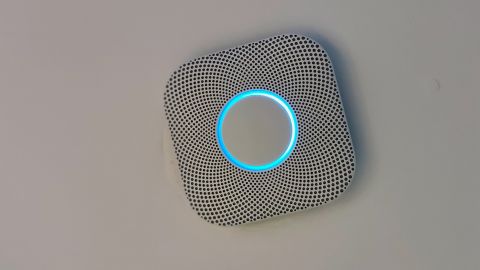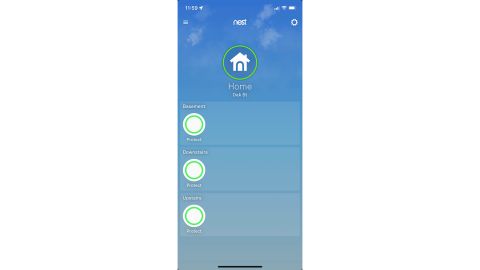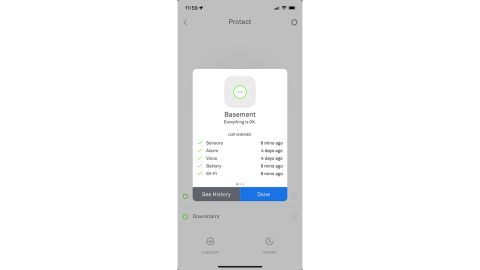
Should you buy a $120 smart smoke detector? This one’s worth it

We’ve all experienced that annoyance: You’re cooking bacon on Sunday morning and the smoke alarm goes off. How convenient would it be to yell, “Bacon!” and have the alarm shut off?
We’re not there yet, but the Google Nest Protect ticks off just about every other wish list item you’d want in a smoke alarm, smart or otherwise. Granted, at $120 each, the Google Nest Protect is more expensive than regular smoke alarms. And maybe it seems like overkill just to handle nuisance alerts like smoking bacon or avoid those low-battery chirps that can drive you mad at 3 am.
If you’re going to invest in a smart smoke alarm (and you should!) the Google Nest Protect is the one to get.
But according to the U.S. Fire Administration, the U.S. has one of the highest per-capita fire death rates in the industrialized world, with some 3,000 people killed and 20,000 injured every year. Three out of five of those deaths were in homes with either no smoke alarm or non-working smoke alarms, often because the batteries had been removed.
Which makes it clear that smoke alarms save lives, but only if they’re working. In our opinion, being able to silence such annoyances from an app on your phone instead of waving a dish towel or climbing a ladder makes it less likely you’ll disconnect the batteries just to avoid these pesky alerts.
Bottom line: If you’re going to invest in a smart smoke alarm (and you should!) the Google Nest Protect is the one to get. Here’s why.
What we liked
Simple setup and an attractive design

The initial setup in the Nest app is easy enough, but Nest Protect isn’t 100% integrated into the Google Home app just yet. So at this time, you’ll have to use your phone’s Nest app for most of the interaction. We expect that to change soon.
If you feel the need to connect it with other ecosystems, like Amazon’s Alexa and Apple’s HomeKit, it will take more finagling, although we did manage to hack together a HomeKit integration using Homebridge, a process too technical for the scope of this review. Alexa requires the installation of additional skills to make Nest work with Alexa. If you just need the Nest Protect’s basic functionality, you can use the Nest app on its own.

Physical installation was simple and quick. We just removed our existing smoke alarms and had the Nest installed and running after about a 10-minute setup and testing session and some basic drilling into the ceiling for the mounting bracket. (Pro tip: Set up the Nest Protect before you mount it since you’ll need to scan a QR code on the back to add it to your home.)
In terms of aesthetics, the Nest Protect looks good. A large central button is framed by a recessed ring LED that glows in red, green, yellow, and blue, depending on the detector’s status. The speaker grill is unobtrusive, making the Nest a stylish but understated addition to the home.
Reliable and clear alerts

The Nest Protect uses what Google calls a Split-Spectrum Sensor, which uses a traditional infrared photoelectric sensor paired with a second, blue LED, to detect slow-burning smoldering fires and fast-burning blazes more quickly.
In our tests, the Nest Protect did a good job of detecting cooking smoke and notifying us that the alarm was about to go off via a calm voice alert that said smoke levels were rising. This gave us enough time to grab our phone and silence the false alarm. If your phone isn’t nearby, the large central button on the Nest Protect itself is easy to push to hush it before it goes off. We also tried it with a slow-burning paper fire and, boy, did it work. (Kids, don’t try this at home.)
The whole warning system was well-designed and escalated thoughtfully. After the initial chime and a calm voice warning, the Nest app began pinging our phones with notifications until finally, the siren went off. This is much better than the usual zero-to-panic that usually happens when smoke alarms go off.
These phone notifications are also handy for when you’re away from home. We didn’t need to test this, thankfully, but we could easily see a situation where a remote notification would cause us to immediately call the fire department if no one was home to check on the house.
Smart connectivity with other Nest products

The Nest Protect alarm connects to other Nest Protects in your house using its own Wi-Fi mesh network, so if the basement smoke alarm goes off, all the smoke alarms go off, even if they’re not detecting smoke at the moment. This interconnectivity is often a requirement for modern smoke alarms, smart or otherwise, so it’s comforting to know the Nest doesn’t rely on your own Wi-Fi, which might not work in a fire, but on its own battery-powered and battery-backup mesh Wi-Fi network.
Nest Protect also interacts with Google’s other Nest products, such as thermostats, cameras, and door locks. In the event it detects smoke, the Nest Protect can shut down the HVAC system using the Nest Thermostat and turn on Nest cameras to record the event.
As an additional safety feature, there’s a Pathlight feature that comes on in a dark room if it detects motion and during an emergency, it turns red to help you escape.
The Nest Protect comes in both a hardwired and battery-powered version. The hardwired option runs off your home’s electricity, comes with a backup of three AA batteries, and offers extra occupancy sensors so it can detect if someone is home and signal your smart home to react if they are not – though this depends on the routines you set up in the Google Home app.
Both versions self-test their sensors and batteries regularly to ensure they’re working. They also test their speakers and alarms once a month during a time period you can set. The ring light on the device indicates its status. If it’s yellow, that means something requires your attention, such as a low battery or a sensor isn’t performing properly. Press the big central button to hear more details, or you can look at the Nest App on your phone for this information.
What we didn’t like
Honestly, other than the cost, there aren’t many cons with the Nest Protect. At $120 per device, this is definitely an investment that you’ll have to refresh every 10 years, as mandated by federal and state regulations. The First Alert Onelink Safe & Sound includes an Alexa smart speaker but it is more expensive ($216). The Onelink Smoke Detector and Carbon Monoxide Detector is cheaper, at $87, but doesn’t offer as many features as the Nest or its more expensive Safe & Sound sibling. We feel the Nest Protect hits the sweet spot between the two for usability, reliability, and integration with other devices.
There are reports of the battery-powered Protect draining more quickly, but so far we haven’t had that problem. We suspect that using lithium AA batteries instead of alkaline will help with this.
Bottom line
The Google Nest Protect is somewhat pricey, but it’s worth it for the ease of use, convenience in silencing alarms, and peace of mind that comes with knowing that no matter where you are, you’ll be alerted to what is happening with your home. It’s stylish, simple to install and it just works well.
Tech Specs
|
Google Nest Protect |
|
|---|---|
| Dimensions | 5.3in x 5.3in |
| Weight | 13.9oz (battery), 13.2oz (wired) |
| Color | White |
| Sensors | Split-Spectrum smokes sensor 10-year electrochemical CO sensor Temperature Humidity Ambient Light Accelerometer Microphone Occupancy (120-degree field of view up to 20 feet) |
| Battery | Battery model: six lithium AA batteries Wired model: three lithium AA batteries |
| Connectivity | Wi-Fi, 802.11b/g/n (2.4Ghz) 802.15.4 (2.4Ghz) Bluetooth Low Energy |
| Operating Temperatures | Normal range is 40 degrees F to 100 degrees F |
| Audio | Speaker Loudness is 80 dB at 3 feet Horn Loudness is 85 dB at 10 feet |
| Warranty | Two-year limited warranty |
| Certification | Complies with safety standards UL 2034, UL 217, and NFPA-72 set out by UL and California State Fire Marshal. |
| Price | $119 |
Source: https://www.cnn.com/cnn-underscored/reviews/google-nest-protect?iid=CNNUnderscoredHPcontainer

















